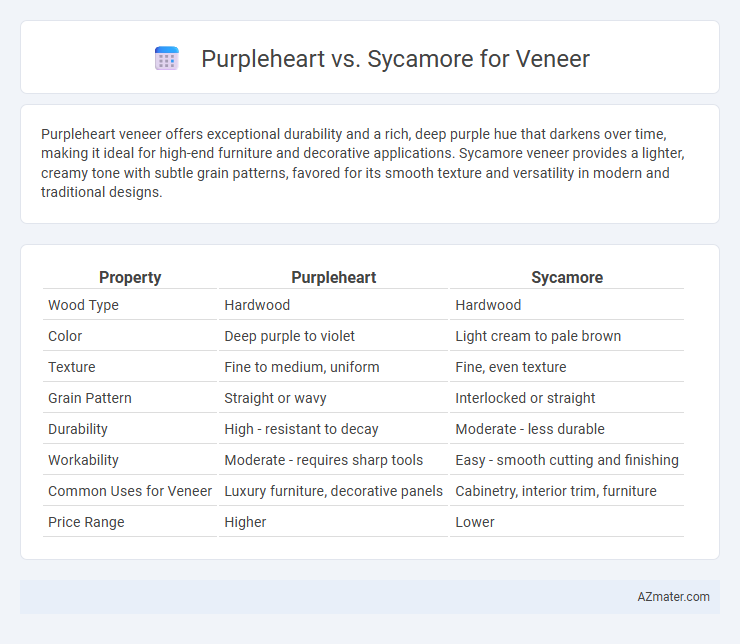Purpleheart veneer offers exceptional durability and a rich, deep purple hue that darkens over time, making it ideal for high-end furniture and decorative applications. Sycamore veneer provides a lighter, creamy tone with subtle grain patterns, favored for its smooth texture and versatility in modern and traditional designs.
Table of Comparison
| Property | Purpleheart | Sycamore |
|---|---|---|
| Wood Type | Hardwood | Hardwood |
| Color | Deep purple to violet | Light cream to pale brown |
| Texture | Fine to medium, uniform | Fine, even texture |
| Grain Pattern | Straight or wavy | Interlocked or straight |
| Durability | High - resistant to decay | Moderate - less durable |
| Workability | Moderate - requires sharp tools | Easy - smooth cutting and finishing |
| Common Uses for Veneer | Luxury furniture, decorative panels | Cabinetry, interior trim, furniture |
| Price Range | Higher | Lower |
Introduction to Purpleheart and Sycamore Veneers
Purpleheart veneer, derived from the Peltogyne genus, features a striking rich purple hue that darkens with age, offering exceptional durability and resistance to wear. Sycamore veneer, sourced from the Acer pseudoplatanus tree, presents a lighter, cream-colored grain with subtle figure variations, known for its smooth texture and ease of finishing. Both veneers are prized in woodworking for their unique aesthetic appeal and structural qualities, making them versatile choices in fine furniture and decorative applications.
Botanical Origins and Species Information
Purpleheart veneer originates from the Peltogyne genus, primarily found in Central and South American tropical rainforests, known for its vibrant purple heartwood. Sycamore veneer comes from various species in the Acer genus, especially Acer pseudoplatanus in Europe and Platanus occidentalis in North America, recognized for its light color and distinctive grain patterns. Both species offer unique botanical characteristics, with Purpleheart prized for its durability and color intensity, while Sycamore is valued for its fine texture and pale appearance.
Visual Appearance and Color Differences
Purpleheart veneer exhibits a rich, vibrant purple hue that deepens to a reddish-brown over time, creating a striking and unique visual appeal for decorative surfaces. Sycamore veneer, contrastingly, presents a lighter, creamy to pale brown coloration with subtle, flowing grain patterns that lend a soft and elegant aesthetic. The distinct color differences make Purpleheart ideal for bold, statement pieces, while Sycamore suits designs requiring a more understated and natural look.
Grain Patterns and Texture Comparison
Purpleheart veneer features a straight to interlocked grain with a smooth, fine texture that showcases its vibrant purple hue, making it a striking choice for decorative applications. Sycamore veneer presents a distinctive, wavy to curly grain pattern with a subtle, even texture that highlights its creamy, pale tones and adds a natural elegance. The contrast between Purpleheart's bold, uniform grain and Sycamore's intricate, flowing patterns allows designers to select veneers based on desired visual impact and tactile appeal.
Durability and Hardness of Each Veneer
Purpleheart veneer exhibits exceptional durability with a Janka hardness rating around 2,520, making it highly resistant to wear and dents, ideal for high-traffic areas. Sycamore veneer, with a lower Janka hardness near 950, offers moderate durability suitable for decorative applications but may not withstand heavy use as effectively. The dense, tight grain structure of Purpleheart contributes to its superior hardness and longevity compared to the softer, more porous Sycamore.
Workability and Machining Properties
Purpleheart veneer is denser and harder than Sycamore, providing superior durability but requiring sharper tools and slower feed rates for clean cuts. Sycamore veneer offers excellent workability with a fine, uniform grain that machines smoothly and sands easily, making it ideal for intricate detailing and fast production. Both veneers respond well to gluing and finishing, but Purpleheart's tougher nature demands more precise handling to avoid tool wear and tear.
Common Applications in Veneer Projects
Purpleheart veneer is prized for its vibrant purple hue and exceptional durability, making it ideal for decorative furniture, custom cabinetry, and high-end architectural millwork. Sycamore veneer offers a lighter, more neutral tone with fine, consistent grain patterns, commonly used in paneling, musical instruments, and intricate marquetry. Both woods provide distinct aesthetic qualities, with Purpleheart adding bold color accents and Sycamore enhancing subtle elegance in veneer projects.
Environmental Impact and Sustainability
Purpleheart veneer, sourced from tropical hardwoods primarily found in Central and South America, often raises concerns about deforestation and habitat disruption due to slower growth rates and selective logging practices. Sycamore veneer, derived from fast-growing temperate trees native to North America and Europe, typically offers a more sustainable option with lower environmental impact, as it supports renewable forestry management and quicker regeneration cycles. Choosing sycamore for veneer production aligns better with eco-friendly building practices by minimizing carbon footprint and promoting sustainable forestry certifications like FSC.
Cost and Availability Analysis
Purpleheart veneer commands a higher price due to its dense hardness and striking deep purple hue, compared to the more affordable and widely available Sycamore veneer known for its light, creamy color and subtle grain. Sycamore is commonly harvested in North America and Europe, resulting in steady supply and lower costs, whereas Purpleheart, primarily sourced from Central and South America, faces limited availability and higher shipping expenses. The cost premium for Purpleheart veneer reflects its rarity and durability, making it a luxury choice versus Sycamore's cost-effective versatility in veneer projects.
Choosing the Right Veneer: Purpleheart or Sycamore
Purpleheart veneer offers exceptional durability and a striking deep purple hue that intensifies with exposure to light, making it ideal for bold, high-end design projects requiring a unique visual impact. Sycamore veneer features a light, creamy color with fine, subtle grain patterns, providing a versatile and elegant option suited for bright, modern interiors emphasizing a natural, understated aesthetic. Selecting between Purpleheart and Sycamore veneers depends on the desired durability, color intensity, and style preference, with Purpleheart excelling in bold durability and Sycamore shining in light warmth and delicate texture.

Infographic: Purpleheart vs Sycamore for Veneer
 azmater.com
azmater.com